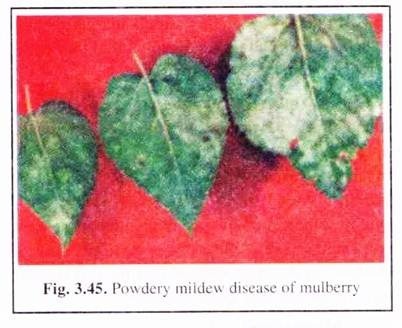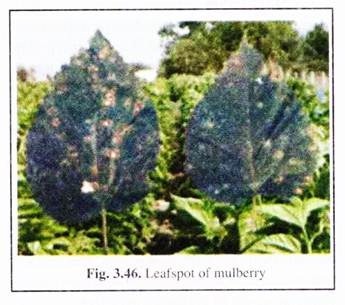The following points highlight the fifteen major diseases of mulberry plants caused by pathogens. The diseases are: 1. Wilt Disease2. Stem Canker Disease 3. Twig Blight Disease 4. Collar Rot Disease 5. Pythium Damping Off Disease 6. Powdery Mildew Disease 7. Leaf Spot Disease 8. Leaf Rust Disease 9. Leaf Blight Disease 10. Leaf Mosaic Disease 11. Yellow Net Vein Disease 12. Dwarf Disease and Others.
1. Wilt Disease:
Stem:
Black patches of fungal mycelia appear on cuttings. The sprouted shoots suddenly wilt and the cuttings ultimately die.
Control Measures:
ADVERTISEMENTS:
Use of chemical fungicide Bavistin or antagonistic fungus Trichoderma as biofungicide.
2. Stem Canker Disease:
Stem:
Greenish black to dark black lesions appear on affected stem.
Control Measures:
ADVERTISEMENTS:
Before plantation, soaking of cuttings in 10 ppm solution of Bavistin or 0.1% carbendazin can prevent canker fungus attack.
3. Twig Blight Disease:
Stem:
The affected stems become feeble, fragile and show irregular black lesions on surface. Gradually the twigs get splitted and dry.
Control Measures:
ADVERTISEMENTS:
Drenching of soil with Captafol or dithane M-45 at a concentration of 0.5% can prevent primary inoculation.
4. Collar Rot Disease:
Stem:
The affected stem turns brown at ground level that gradually encircles the shoot as a collar. Leaves on it show withering.
Control Measures:
It is a soil-borne disease. So pruning the stem at a height of 80 cm above the ground and subsequently at lower level can check the contamination.
5. Pythium Damping Off Disease:
Stem. Affected stem shows water soaked patches at first that become brown to black patches ultimately. Terminal leaves wilt and fall off.
Control Measures:
This deadly epidemic disease of mulberry plant can be checked by soaking the cuttings in fungicides prior to plantation.
6. Powdery Mildew Disease:
Leaf. Initially white powdery patches appear on ventral surface of affected leaves (Fig. 3.45) that later become brown to black and cover whole leaf. Affected leaves become dry, leathery and fall off.
Control Measures:
Physical:
Picking and burning of diseased leaves. Harvesting leaves at proper time. Proper pruning and weeding increase air circulation and reduce humidity.
Chemical:
Spraying of Morestan, Karathana, sulpher power to entire field. Spreading of lime-sulphur mixture on the underside of leaves. Biological: Release of predatory spotted lady beetle in the field.
7. Leaf Spot Disease:
Leaf:
Affected leaves show small white circular/irregular spots with a yellow halo (Fig. 3.46); leaves ultimately fall off.
Control Measures:
Removal of weeds (alternate host) from field. Picking and burning of affected leaves. Spraying of Bavistin or Difolatan, etc.
8. Leaf Rust Disease:
Leaf:
Affected leaves including green apical shoot show small irregular reddish borwn spots (Fig. 3.47). Leaves loss their shape.
Control Measures:
Affected leaves should be picked up and burned. Spraying of lime sulphur mixture, Antracol, dithane, etc.
9. Leaf Blight Disease:
Leaf:
Affected leaves show water soaked irregular spots at lower side to brown spots with yellow margin at upper side. Leaves become wrinkled and curled outwards. In wet weather, the spotted area fall off but in dry weather, leaf-spots remain as dry on intact leaf.
Control Measures:
Disease resistant variety may be planted. Diseased plants should be removed and destroyed immediately. Spraying of foliar sprays like phytobacteriomycin may be effective.
10. Leaf Mosaic Disease:
Leaf:
Affected leaves show mosaic dark green patches without chlorophyll around the veins. Leaves wrinkle, with chloric lesions. The shoot tips shorten and leaf size also reduced. Total leaf yield reduces.
Control Measures:
Only preventive measures can be taken against such diseases. Removing and burning of affected plants, removing all old crops from field. Exposure of plant-cultivating apparatus to high temperature, washing the hands and tools with disinfectants. Plantation of virus-resistant variety.
11. Yellow Net Vein Disease:
Leaf:
Virus affected leaves turn yellow with net-vein appearance. The leaves become distorted and twined. The plant growth also retarded.
Control Measures:
Only preventive measures can be taken against such diseases. Removing and burning of affected plants, removing all old crops from field. Exposure of plant-cultivating apparatuses to high temperature, washing the hands and tools with disinfectants. Plantation of virus- resistant variety.
12. Dwarf Disease:
Leaf and branches:
Affected parts show short, fragile branches with irregularly arranged leaves.
Control Measures:
Only preventive measures can be taken against such diseases. Removing and burning of affected plants, removing all old crops from field. Exposure of plant-cultivating apparatuses to high temperature, washing the hands and tools with disinfectants. Plantation of virus-resistant variety.
13. Nematode Disease:
Root:
Stunted plant growth and reduced leaf-yield. Galls are present on rootlets and on feeder.
Control Measures:
Fallowing the land, mulching the soil, rearing resistant variety. Application of organic fertilizers like neem oil cake, and compost can check nematode attack.
14. Root Rot Diseases:
(i) White Root Rot:
Root:
Weak growth of plant, shedding of leaves, feeble growth of buds, rotting of roots showing white patches of mycelium.
(ii) Violet Root Rot:
Same as white root rot except the rotten root and stump show violet patches of fungal mycelia.
(iii) Fusarium Root Rot:
Root:
The surface of root beneath the bark and cortex becomes gummy. The plants die ultimately.
Control Measures:
For different root rot diseases of mulberry plant, following physical, chemical and biological control measures are useful:
(a) Physical method:
The diseased plant should be uprooted, burnt; the soil around that plant will be dug out and removed to far-off places. The soil should be sterilised by putting calcium cyanamide (2400 gm/m2) in one metre deep holes.
(b) Chemical method:
Before plantation, soil can be mixed with 6.1% Terrazole or 23% PCNB (Pentachloro-nitroben- zene). The pits can be dusted with 2-3% of dithane 45 before planting. The cuttings or samples can be dipped in 0.2%. Bavistin solution or 20% lime water and should be washed in water before plantation.
(c) Biological control:
Some biofungicides like Trichoderma, Bacillus, Pseudomonas, etc. can be used to check the growth of root rotting fungi.
15. Stem Rot/Heart Rot Disease:
Stem:
The heart wood of branches/ shoots are attacked resulting in drying, rotting of twig and branches. The attacked plants ultimately die.
Control Measures:
The branch/twig should be free from wound or any cut. The branches of affected tree should be detached and burnt immediately.


